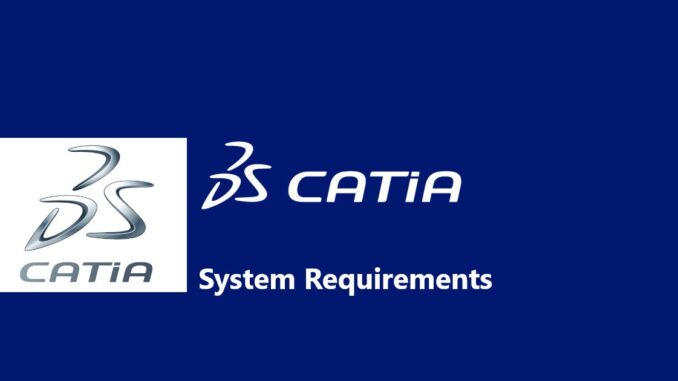
Catia System Requirements are crucial to successful and enjoyable design integrity. If you want to undertake exciting and fascinating works, feel the design difference and inspire new engineering works, you should not ignore the following criteria.

- Operating System: Microsoft Windows 7 or Windows 10,11 (64-bit)
- Memory (RAM): Minimum 2GB 32-bit and 4GB 64-bit. Swap space requires twice the available RAM. (4GB RAM – 8GB or more is highly recommended)
- Hard Disk Space: 10 GB Free Hard Disk space
- Processor: Multi-core, 64-bit processor (e.g. Intel i5, i7 or Xeon)
- Resolution: Minimum WXGA+ (1440 x 900)
- Office: Microsoft Office 2013 or newer for report generation
- Graphics card: A dedicated NVIDIA OpenGL-capable graphics card is required; An NVIDIA Quadro M2000 (4GB GDDR5) or better is highly recommended to ensure that no graphics issues occur. NVIDIA graphics driver must be version 350 or higher. For more information about the recommended NVIDIA setting, it is possible to transfer.
Catia V5 System Requirements
Catia V5 System Requirements should be as follows.
- Microsoft Windows 7 or Windows 10,11 (64-bit)
- Multi-core, 64-bit processor (e.g. Intel i5, i7 or Xeon)
- Dedicated graphics card recommended (not integrated into the motherboard like Intel Integrated graphics)
- 4GB RAM – 8GB or more highly recommended
- 10 GB Free Hard Disk space
- Microsoft Office 2013 or newer for report generation
CATIA V5 graphics card requirements
While a dedicated graphics card is not strictly necessary to run CATIA V5, it is highly recommended for a smoother experience, especially when working with complex models and large assemblies.
Here are the minimum graphics card requirements for CATIA V5:
- Graphics adapter: A graphics adapter with a 3D OpenGL accelerator is required.
- Resolution: Supports 1024 x 768 resolution with a minimum of 16 million colors.
These are the very basic requirements, and you’ll likely experience performance issues, especially with larger or more complex models, if you don’t have a more powerful graphics card.
For optimal performance, Dassault Systèmes, the developers of CATIA, recommend using a certified workstation. These workstations have been tested and approved to meet the performance requirements of CATIA V5.
Here are some additional factors to consider when choosing a graphics card for CATIA V5:
- VRAM: More VRAM (video RAM) will allow you to work with larger and more complex models without experiencing performance issues.
- CUDA cores: If you plan on using CATIA V5 for rendering or other tasks that can benefit from GPU acceleration, you’ll want a graphics card with a good number of CUDA cores.
- Driver support: Make sure the graphics card you choose has up-to-date drivers that are compatible with CATIA V5.
3DEXPERIENCE system requirements
Here’s a general overview of the hardware specifications that are recommended for running the 3DEXPERIENCE platform on the cloud:
- Operating system: Windows 10 64-bit or Windows 11 64-bit
- Processor: Intel Core i7 or equivalent AMD processor
- Graphics card: NVIDIA Quadro RTX 4000 or equivalent
- RAM: 32 GB or more
- Storage: Solid state drive (SSD)
Catia Minimum Requirements
- Operating system: Windows 7
- Ram: 4 GB
- 10 GB Free Hard Disk space
- Screen Resolution 1024 x 768
Catia PC Requirements
- OS: Windows 7 or higher
- Ram: 4 GB
- Minimum 10 GB Free Hard Disk space
Catia Laptop Requirements
- Operating system: Windows 7 or higher
- Ram: 4 GB
- Minimum 10 GB Free Hard Disk space
- Minimum Screen Resolution 1024 x 768